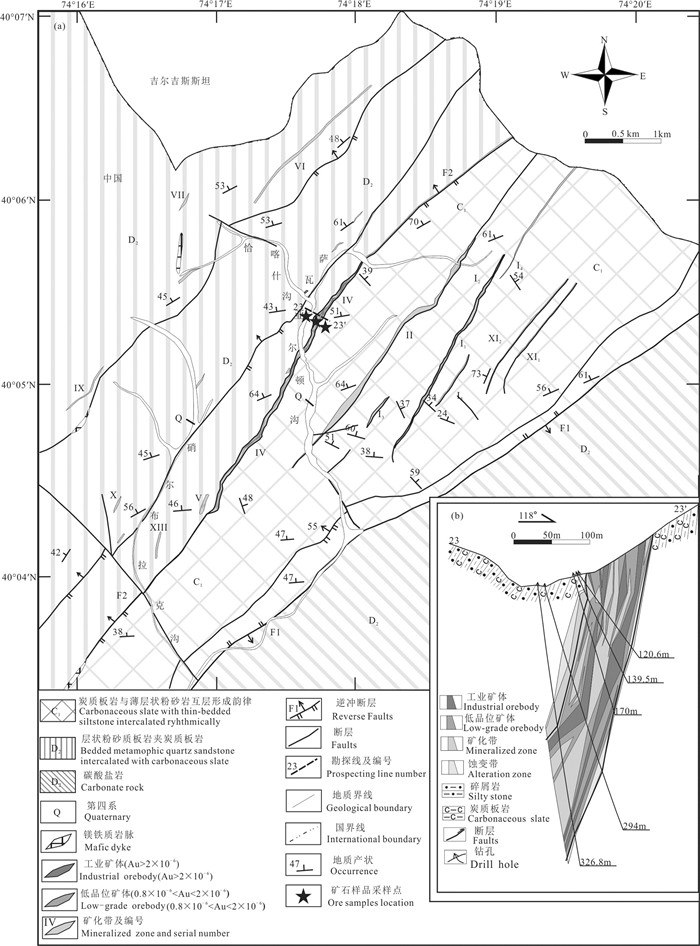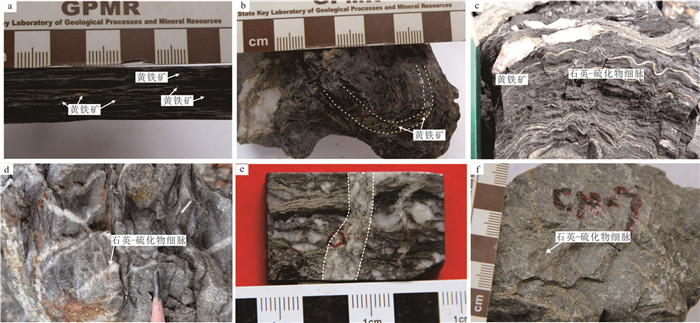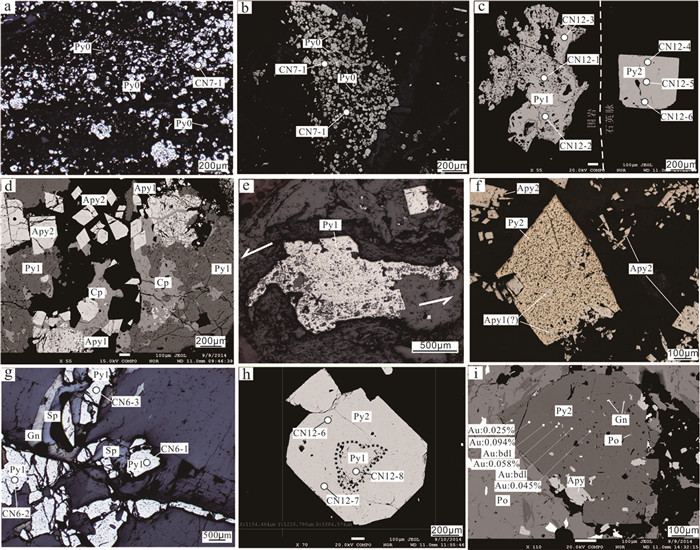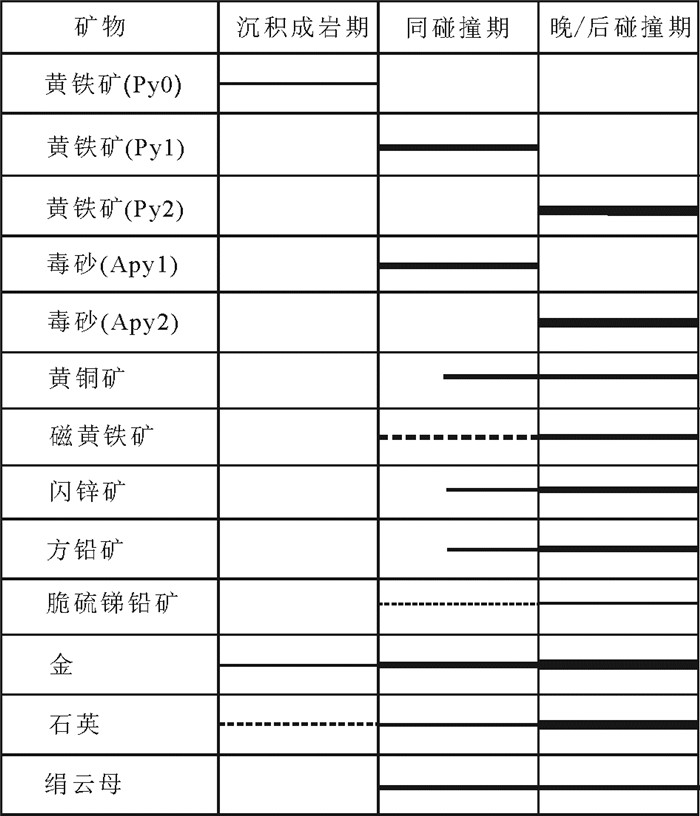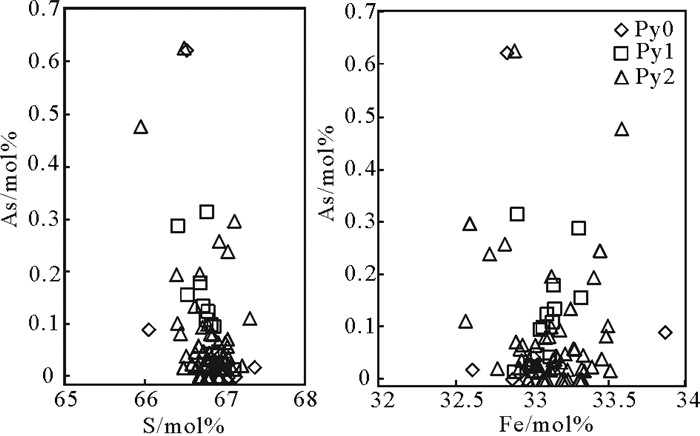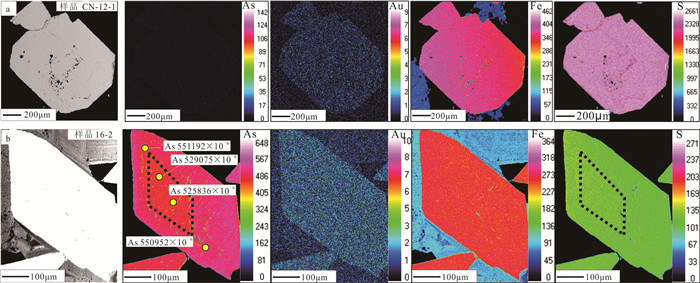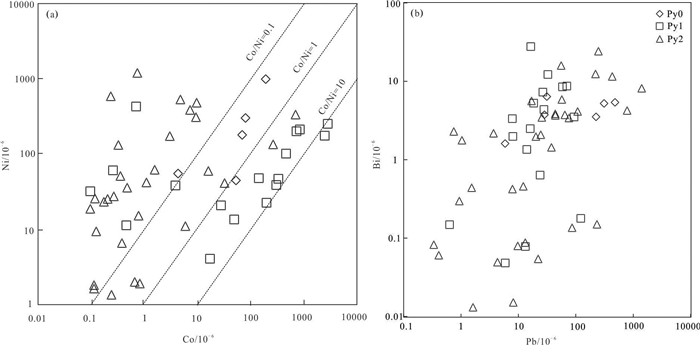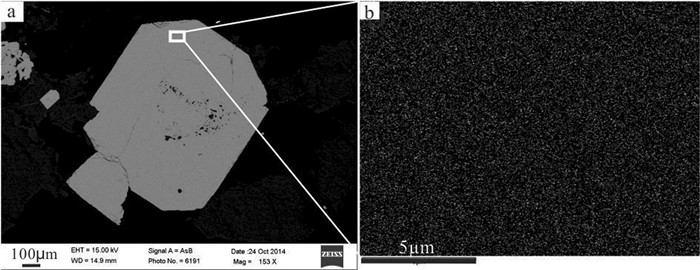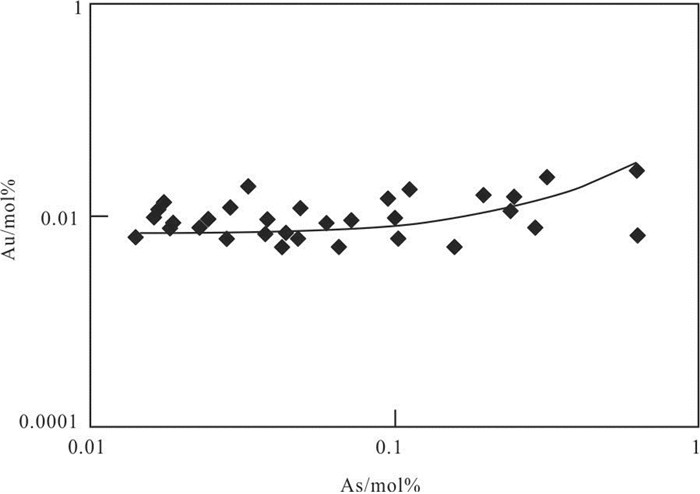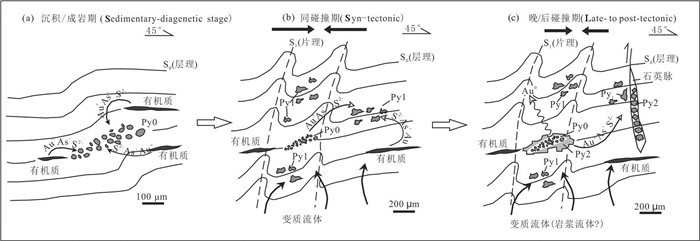The ore-forming process of the Sawayaerdun gold deposit, western Tianshan, Xinjiang: Contraints from the generation relationship and EMPA, LA-ICP-MS and FESEM analysis of the Pyrite and Arsenopyrite
-
摘要:研究目的
为确定硫化物中金的赋存状态及元素含量特征。
研究方法本文选取西天山萨瓦亚尔顿造山型金矿床(探明金储量127 t,远景资源量350 t),针对矿石矿物黄铁矿、毒砂开展系统显微岩/矿相学观测、电子探针、LA-ICP-MS和扫描电镜分析。
研究结果结果表明萨瓦亚尔顿矿石中除可见金外,还有"不可见金"主要以固溶体(Au+)形式赋存于黄铁矿、毒砂中。矿石中载金黄铁矿发育3期:球丛状黄铁矿(Py0)呈浸染状分布于围岩中,局部富含金,同时富集Ag、As、Bi、Ni、Cu、Pb、Sb等微量元素;他形黄铁矿(Py1),分布于硅化围岩及强烈变形石英脉中,与他形毒砂(Apy1)伴生,电子探针得到的平均金含量为0.050%,富集Co、Mn、Zn等微量元素;自形-半自形黄铁矿(Py2),在矿体中分布最为广泛,与未变形石英脉密切共生,伴生自形毒砂(Apy2),电子探针分析得到的平均金含量为0.052%,微量元素相对Py1、Py2较为亏损。
结论推测Py0形成于沉积成岩期;Py1形成于同碰撞期,与塔里木板块与中天山地块在晚石炭世碰撞事件有关;Py2形成于晚/后碰撞阶段。赋矿地层可能是金的初始矿源层,同时提供了部分微量元素,地层变质脱水作用形成的变质流体是主要的成矿流体。研究表明萨瓦亚尔顿金矿发育多期成矿作用,相似成矿过程在西天山同类型矿床中可能也有发生。
创新点:识别出三期载金黄铁矿(Py0、Py1、Py2);查明硫化物含金型及微量元素含量特征;探讨硫化物形成与大地构造背景的关系。
Abstract:This paper is the result of mineral exploration engineering.
ObjectiveTo determine the occurrence of Au and elements feature of the sulfide.
MethodsThe Sawayaerdun orogenic gold deposit (explored Au: 127 t, prospective Au: 350 t) in the western Tianshan is chosen and the microscopic petrography study, EMPA, LA-ICP-MS and FESEM analysis have been applied.
ResultsExcept for "visible gold", the result indicate that "invisible gold" is likely present as solid soluation (Au+) in the pyrite and arsenopyrite in the Sawayaerdun deposit. Three generations of auriferous pyrite have been recognized. The pyrite with framboidal texture (Py0) are disseminated in the host rock, and are locally enriched in gold. They have relatively high values of Ag、As、Bi、Ni、Cu、Pb、Sb. The anhedral pyrite (Py1), associated with silicified rocks and quartz veins that experienced strong deformation, have an average Au content of 0.050%. They have high contents of Co、Mn、Zn. The euhedral-subhedral pyrite (Py2) are best developed in the main orebodies, and have an average Au content of 0.052%. Comparing to Py1, Py2, they have lower contents of trace elements.
ConclusionsThe Py0 are interpreted to have formed contemporaneously with the ore-bearing rocks. Py1 are interpreted to have formed in the syn-tectonic stage, during the collision between the Tarim craton and the Central Tianshan terrane in the Late Carboniferous, whereas Py2 were formed in a later mineralization event, during the late- to post-tectonic stage in the Early Permian. Ore-bearing strata could be the initial source bed of gold, meantime provides the trace elements when forming gold-bearing sulfides. The ore-forming fluids were probably metamorphic fluids deriving from dehydration of the sedimentary strata. The study results suggest that multi-stage of gold mineralization have developed in the Sawayaerdun deposit, similar metallogenic process may exist in other homogeneous deposits in the Western Tianshan Orogen.
-
1. 引言
硫化物尤其是黄铁矿广泛发育于造山型金矿床、浅成低温热液型金矿床、卡林型金矿床、斑岩型铜金矿床等热液矿床,通常作为载金矿物贯穿于矿床形成的各个阶段(Large et al., 2009;2013;Genna et al., 2015;Wu et al., 2019;Xu et al., 2020)。因此研究黄铁矿对于揭示成矿机理、约束成矿过程、探索成矿物质来源具有重要意义。
萨瓦亚尔顿金矿床位于中国新疆与吉尔吉斯斯坦边境线附近中方一侧,20世纪90年代发现。近期勘探已探明金储量127 t,远景资源量约350 t(Rui et al., 2002;陈华勇等,2013;薛春纪等,2014a),是新疆一个世界级造山型金矿床(刘家军等,2002a;Yang et al., 2007;Liu et al., 2007;陈华勇等,2013;薛春纪等, 2014b, 2015;李俊健等,2021)。前人对萨瓦亚尔顿金矿床地质特征(刘家军等,2002a;杨富全等,2005)、地球化学(叶锦华等,1999a;郑明华等,2002;Chen et al., 2012b)、成矿时代(叶锦华等,1999b;刘家军等,2002b;杨富全等,2006)、成矿流体(陈华勇等, 2007, 2013;Chen et al., 2012a)等方面做了较多研究,但对于广泛发育的黄铁矿研究还很缺乏。宏观上通过矿物组合及穿插关系,刘家军等(2002a)划分出5种含金矿物组合:金-毒砂-黄铁矿-石英、金-黄铁矿-脆硫锑铅矿-(辉锑矿)-石英、金-脆硫锑铅矿-(辉锑矿)、金-石英-菱铁矿和金-黄铁矿-磁黄铁矿-石英。郑明华等(2002)据矿化脉穿插关系,将矿化分为无矿石英、金-黄铁矿-毒砂-石英、金-多硫化物-石英-(菱铁矿)、辉锑矿-石英、石英-菱铁矿等5个阶段。可以看出黄铁矿等硫化物发育于成矿各个阶段,但对于不同阶段硫化物类型、特征缺乏细致研究。郑明华等(2001)对矿石中黄铁矿、毒砂等进行了电子探针分析,指出毒砂为载金矿物,而黄铁矿不是载金矿物。王玉山等(2008)提出与金矿化最密切的为黄铁矿、毒砂、辉锑矿等硫化物,金在黄铁矿、毒砂中以“不可见金”的形式存在。可见硫化物是主要载金矿物,但是金的赋存状态存在争议,而硫化物中其他微量元素的含量及变化未见报道。
本文主要针对矿石中载金硫化物开展系统的岩/矿相学观测,通过宏观穿插关系到微观粒度、晶形、交生关系、共/伴生矿物组合等方面的研究,区分出不同阶段和不同世代的载金硫化物矿物,采用电子探针(EMPA)、激光剥蚀等离子质谱(LA-ICP-MS)和场发射扫描电镜(FESEM)对不同阶段和世代的载金硫化物载金性及微量元素含量进行了系统的分析,旨在示踪成矿物质来源,精细刻画成矿过程。
2. 区域和矿床地质
萨瓦亚尔顿金矿床位于中国新疆西南天山,接近中国—吉尔吉斯斯坦边界(图 1)。区域前寒武纪基底出露于矿区东南部,由中元古代长城系片岩、片麻岩及大理岩组成,上覆古生代厚层复理石及碳酸盐岩建造(Yang et al., 2007)。随着南天山洋俯冲消减闭合,塔里木板块与中天山板块在晚石炭世闭合,导致区域发生强烈的变形-褶皱及逆冲推覆构造,地层整体发生绿片岩相浅变质作用(高俊等,2006;Yang et al., 2007;Gao et al., 2009;牛树银等,2013)。阿热克托如克和伊尔库什坦断裂与萨瓦亚尔顿金矿空间位置最为密切,断裂呈南西走向,倾向北西,显示走滑剪切性质(Liu et al., 2007;Chen et al., 2012a)(图 1)。中生代河流-湖泊相碎屑沉积岩发育于区域东南部,被塔里木盆地新生代陆相碎屑岩覆盖(图 1;Yang et al., 2007)。
![]() 图 1 萨瓦亚尔顿地区区域地质简图(据陈华勇等,2013修编)Figure 1. Sketch map of western part of the Chinese Southern Tianshan showing the location of the Sawayaerdun gold deposit (modified from Chen Huayong et al., 2013)
图 1 萨瓦亚尔顿地区区域地质简图(据陈华勇等,2013修编)Figure 1. Sketch map of western part of the Chinese Southern Tianshan showing the location of the Sawayaerdun gold deposit (modified from Chen Huayong et al., 2013)萨瓦亚尔顿金矿床赋矿地层为一套古生代发生绿片岩相浅变质作用的浊积岩系(Liu et al., 2007;彭静等,2010)。地层时代存在不同认识,最新发表的U-Pb碎屑锆石年龄数据限定矿区西北部F2断层上盘的地层为中泥盆统,矿区西南部F2断层下盘的地层为下石炭统(图 2a;Zhang et al., 2017)。矿区西北部中泥盆统主要为灰色—深灰色中—薄层粉砂质板岩夹黑色炭质板岩。中部下石炭统为炭质板岩与薄层状粉砂质板岩互层,是主要的赋矿层位。矿区东南部中泥盆统主体为一套碳酸盐岩,接近F1断层处下石炭统近直立,粉砂质板岩占比例增大且有钙质粉砂岩顺层产出,而碳酸盐岩呈陡立的孤峰,岩石普遍破碎或沿节理裂开。
![]() 图 2 萨瓦亚尔顿金矿床地质简图(a)萨瓦亚尔顿金矿区IV号矿带23勘探线剖面图(b)(据新疆地质矿产局第二地质大队,2014修改)Figure 2. Sketched map showing the geology of the Sawayaerdun gold deposit (a) and Geological section along No.23 exploration line of the IV mineralized belt in the Sawayaerdun gold deposit (b) (modified from Geological Team No.2, Xinjiang Bureau of Geology and Mineral Resources, 2014)
图 2 萨瓦亚尔顿金矿床地质简图(a)萨瓦亚尔顿金矿区IV号矿带23勘探线剖面图(b)(据新疆地质矿产局第二地质大队,2014修改)Figure 2. Sketched map showing the geology of the Sawayaerdun gold deposit (a) and Geological section along No.23 exploration line of the IV mineralized belt in the Sawayaerdun gold deposit (b) (modified from Geological Team No.2, Xinjiang Bureau of Geology and Mineral Resources, 2014)矿区发育一系列韧脆性逆冲推覆构造,大多数南西走向,倾向北西,部分倾向南东(Liu et al., 2007)(图 2a)。局部断裂构造极为发育,不同类型、不同性质的断裂构造先后形成于不同的构造环境之中,并且在时空演化上多期复合叠加活动明显。岩石变形形成的面理和线理极为发育,A型小褶皱广泛分布,赋矿地层中板岩和千枚岩由于动力变质作用形成碎斑结构,岩石变形的强弱带呈交替出现等都显示了矿区韧性剪切带的发育(Yang et al., 2007)。
矿区内未见大型侵入体出露,只有少量镁铁质岩枝/岩脉出露于矿区西南部,走向北东或近南北向(图 2a)(Liu et al., 2007)。K-Ar同位素测年得到(207.5±4.2) Ma~(187±18) Ma和(164.4±2.6) Ma~(137.9±3.8) Ma两期年龄,可能记录了印支期及燕山期构造-岩浆热事件(Liu et al., 2007)。陈富文和李华芹(2003)对矿区出露的二长斑岩脉进行了单颗粒锆石U-Pb测年,得到133.7~131.0 Ma的结晶年龄,提出岩浆侵位发生在晚侏罗世—早白垩世。属燕山中晚期岩浆活动产物。
金矿化赋存于一系列南西走向,倾向北西的韧性剪切带之中,这些韧性剪切带及矿体同时被代表晚期破矿构造的北西走向脆性断裂所切断(图 2a)。矿区沿着主要的逆冲推覆构造圈定出24个矿体。其中四号矿体长度超过4000 m,宽度变化于20~100 m,是矿区已知最大矿体,单个矿体具有超过70 t的金资源量,品位变化于1.4~5.9 g/t (叶锦华等,1999a;Liu et al., 2007;Yang et al., 2007)。矿体呈似层状、透镜状或脉状产出,走向南西,倾向北西,倾角介于60~70°(图 2b)。
主要的赋矿岩系炭质板岩之中含有少量黄铁矿(图 3a),可能为沉积/成岩期产物。单个矿体主要由大量含金石英脉、石英细脉和少量方解石脉组成(石英脉型矿石),还有硫化物矿物呈浸染状分布于围岩之中(蚀变岩型矿石)。矿体中硅化和硫化物矿化(主要为黄铁矿化、毒砂化)的炭质板岩(图 3b)、石英-硫化物脉(细脉)(图 3c)及石英脉(图 3c)平行或近平行于片理且同时发生强烈变形(揉皱及石香肠化),后被显示脆性性质的石英-硫化物细脉切穿(图 3d、e、f)。
![]() 图 3 萨瓦亚尔顿矿石、围岩手标本照片a—炭质板岩,含有早期成岩期浸染状黄铁矿;b—黄铁矿与毒砂呈浸染状分布于蚀变岩石中,并与蚀变岩一起揉皱变形;c—近平行于片理的石英-硫化物细脉;d—石英-硫化物细脉;e—切穿片理的黄铁矿-毒砂-石英细脉;f—石英-硫化物细脉、网脉切穿片理及蚀变岩Figure 3. Photographs showing various types of ores and host rocks from the Sawayaerdun gold deposita-Carbonaceous slate with early diagenetic pyrite disseminated in it; b-Pyrite and arsenopyrite disseminated in the altered rock that has been foliated and folded; c-Quartz-sulfide veinlet subparallel to the foliation; d-Quartz-sulfide veinlets; e-A quartz-pyrite-arsenopyrite vein crosscutting the foliation; f-Quartz-sulfide veinlets and stockworks crosscutting the foliation and altered rock
图 3 萨瓦亚尔顿矿石、围岩手标本照片a—炭质板岩,含有早期成岩期浸染状黄铁矿;b—黄铁矿与毒砂呈浸染状分布于蚀变岩石中,并与蚀变岩一起揉皱变形;c—近平行于片理的石英-硫化物细脉;d—石英-硫化物细脉;e—切穿片理的黄铁矿-毒砂-石英细脉;f—石英-硫化物细脉、网脉切穿片理及蚀变岩Figure 3. Photographs showing various types of ores and host rocks from the Sawayaerdun gold deposita-Carbonaceous slate with early diagenetic pyrite disseminated in it; b-Pyrite and arsenopyrite disseminated in the altered rock that has been foliated and folded; c-Quartz-sulfide veinlet subparallel to the foliation; d-Quartz-sulfide veinlets; e-A quartz-pyrite-arsenopyrite vein crosscutting the foliation; f-Quartz-sulfide veinlets and stockworks crosscutting the foliation and altered rock可见金主要以自然金或者银金矿的形式存在于石英脉裂隙中或者硫化物裂隙及内部(Liu et al., 2007),“不可见金”的存在形式仍有待揭示。分布于矿体及围岩中的硫化物主要包括黄铁矿、毒砂、磁黄铁矿、黄铜矿、闪锌矿、方铅矿等,研究中也发现少量脆硫锑铅矿。此外,Liu et al. (2007)还发现少量白铁矿、辉锑矿、方钴矿、银黝铜矿、辉铋矿、自然铋等矿物。其中,最常见的含金硫化物为黄铁矿及毒砂(Liu et al., 2007;Yang et al., 2007)。根据硫化物产出状态和穿插关系,可判断其先后顺序为:(1)浸染状(局部且不连续)分布于炭质板岩的黄铁矿(图 3a);(2)与硅化及石英脉一起经历强烈揉皱变形的硫化物(图 3b、c);(3)与非变形石英脉及石英细脉共生的硫化物(图 3d、e、f)。
根据主要硫化物矿物的大小、晶形、产状及交生关系,矿石中黄铁矿可划分出3个世代:第一期黄铁矿(Py0)呈球丛状沿地层片理分布(图 4a, b)。第二期黄铁矿(Py1)通常显示他形晶结构,磨光差,发育大量裂纹与孔洞(图 4c),孔洞多集中于矿物边部(图 4e、h),可见被后期黄铜矿充填交代(图 4d)。Py1与自形—半自形毒砂(Apy1)共生,毒砂也显示破碎的表面(图 4d)。在局部可见Py1因变形作用拉伸的现象(图 4e)。第三期黄铁矿(Py2)呈自形-半自形晶型且具有保存良好的晶体结构,与Py1相比表面干净,没有裂纹(图 4e, f),与自形毒砂(Apy2)共生。Re-Os法测得第二期黄铁矿(Py1)和第三期黄铁矿(Py2)形成年龄分别为(323.9±4.8)Ma与(282±12)Ma(Zhang et al., 2017)。
![]() 图 4 显微照片显示产于矿石及围岩中各种硫化物特征a-b—球丛状黄铁矿(Py0);c—他形黄铁矿(Py1),与自形—半自形黄铁矿共存(Py2);d—他形黄铁矿(Py1)与自形黄铁矿(Py2)共生,并被黄铜矿(Cp)交代;e—他形黄铁矿(Py1)在变形过程中被拉长;f—自形黄铁矿(Py2)与毒砂共生(Apy2);g—他形黄铁矿(Py1)与方铅矿及闪锌矿共生;h—他形黄铁矿(Py1)被自形黄铁矿(Py2)包裹;i—自形黄铁矿(Py2)包含方铅矿及毒砂包体;黄色实圈为LA-ICP-MS点,简写:Py=黄铁矿;Apy=毒砂;Gn=方铅矿;Cp=黄铜矿;Sp=闪锌矿。a-b, e-g: 反射光;c-d, h-i: BSE图像Figure 4. Photomicrographs showing various occurrences of sulfides in the ores and host rocksa- b- Framboidal pyrite (Py0); c- Anhedral pyrite (Py1) coexisting with euhedral- subhedral pyrite (Py2); d- Py1 and Apy1 in coexistence and replaced by Cp; e-Anhedral pyrite (Py1) stretched during deformation; f-Euhedral pyrite (Py2) coexisting with arsenopyrite (Apy2); g-anhedral pyrite (Py1) coexisting with sphalerite and galena; h-Euhedral pyrite (Py2) overgrowing anhedral pyrite (Py1); i-Subhedral pyrite (Py2) containing inclusions of galena and arsenopyrite. Yellow rim represents LA- ICP- MS spot, Abbreviations: Py=Pyrite; Apy=Arsenopyrite; Gn=Galena; Cp= Chalcopyrite; Sp=Sphalerite. a-b, e-g: Reflected light; c-d, h-i: BSE imagines
图 4 显微照片显示产于矿石及围岩中各种硫化物特征a-b—球丛状黄铁矿(Py0);c—他形黄铁矿(Py1),与自形—半自形黄铁矿共存(Py2);d—他形黄铁矿(Py1)与自形黄铁矿(Py2)共生,并被黄铜矿(Cp)交代;e—他形黄铁矿(Py1)在变形过程中被拉长;f—自形黄铁矿(Py2)与毒砂共生(Apy2);g—他形黄铁矿(Py1)与方铅矿及闪锌矿共生;h—他形黄铁矿(Py1)被自形黄铁矿(Py2)包裹;i—自形黄铁矿(Py2)包含方铅矿及毒砂包体;黄色实圈为LA-ICP-MS点,简写:Py=黄铁矿;Apy=毒砂;Gn=方铅矿;Cp=黄铜矿;Sp=闪锌矿。a-b, e-g: 反射光;c-d, h-i: BSE图像Figure 4. Photomicrographs showing various occurrences of sulfides in the ores and host rocksa- b- Framboidal pyrite (Py0); c- Anhedral pyrite (Py1) coexisting with euhedral- subhedral pyrite (Py2); d- Py1 and Apy1 in coexistence and replaced by Cp; e-Anhedral pyrite (Py1) stretched during deformation; f-Euhedral pyrite (Py2) coexisting with arsenopyrite (Apy2); g-anhedral pyrite (Py1) coexisting with sphalerite and galena; h-Euhedral pyrite (Py2) overgrowing anhedral pyrite (Py1); i-Subhedral pyrite (Py2) containing inclusions of galena and arsenopyrite. Yellow rim represents LA- ICP- MS spot, Abbreviations: Py=Pyrite; Apy=Arsenopyrite; Gn=Galena; Cp= Chalcopyrite; Sp=Sphalerite. a-b, e-g: Reflected light; c-d, h-i: BSE imagines综合以上分析,Py0为最早期黄铁矿,可能为同生/成岩期产物。他形黄铁矿(Py1)与自形黄铁矿(Py2)为热液期产物。他形黄铁矿(Py1)形成于变形期(同碰撞期),而自形黄铁矿(Py2)很可能形成于主变形期之后(晚/后碰撞期)。Py0所占比例远小于Py1和Py2。矿物的主要生成顺序列于图 5。
![]() 图 5 萨瓦亚尔顿金矿床矿物生成顺序(线条粗细代表矿物含量相对多少,虚线代表矿物可能存在,断线代表矿物只存在于某个阶段)Figure 5. Paragenetic sequence of minerals in the Sawayaerdun gold deposit(The thickness of the line represents the relative content of the mineral, the dotted line represents the possible existence of the mineral, and the broken line represents the mineral only exists in a certain stage)
图 5 萨瓦亚尔顿金矿床矿物生成顺序(线条粗细代表矿物含量相对多少,虚线代表矿物可能存在,断线代表矿物只存在于某个阶段)Figure 5. Paragenetic sequence of minerals in the Sawayaerdun gold deposit(The thickness of the line represents the relative content of the mineral, the dotted line represents the possible existence of the mineral, and the broken line represents the mineral only exists in a certain stage)3. 样品分析及结果
3.1 样品和分析方法
本次研究的矿石样品采自IV号矿体23勘探线中段平硐,显微镜下观察其中主要脉石矿物为石英、方解石,硫化物矿物主要为黄铁矿、毒砂,少量黄铜矿、方铅矿、闪锌矿、脆硫锑铅矿、磁黄铁矿等。显微镜下没有见到自然金或银金矿独立矿物。
将矿石标本磨制成探针片及光片,先在显微镜下观察和圈定待测位置,喷碳后进行电子探针、激光剥蚀等离子质谱和场发射扫描电镜分析。在中国地质科学院矿产资源研究所完成电子探针分析,仪器型号为JXA-8230,加速电压20 kV,电流20 nA,束斑直径3~5 μm,分析元素对应的标样矿物为金属、化合物及天然硫化物,其中金含量检测下限取257×10-6。分析包括点分析、线扫描和对典型矿物Au、As、S、Fe元素的面扫描。
硫化物LA-ICP-MS分析在国家地质实验测试中心完成,使用仪器为Thermo Element Ⅱ等离子质谱仪,激光剥蚀系统为NEW WAVE UP-213。实验采用He作为剥蚀物质的载气,激光波长213 nm、束斑40 μm、脉冲频率10 Hz、能量0.176 mJ、密度23~25 J/m2,测试过程中首先遮挡激光束进行空白背景采集15 s,然后进行样品连续剥蚀采集45 s,停止剥蚀后继续吹扫15 s。清洗进样系统,单点测试分析时间75 s。等离子质谱测试参数为冷却气流速(Ar)15.55 L/min;辅助气流速(Ar)0.67 L/min;载气流速(He)0.58 L/min;样品气流速0.819 L/min,射频发生器功率1205 W。测试数据采用内标外标相结合的方法,内标为Fe元素,外标样使用NIST 612。测试元素包括Ag、As、Bi、Co、Cu、Ga、Mn、Mo、Ni、Pb、Sb等微量元素,由于缺乏有效的Au标样,金的含量没有检测。
在中国地质大学(北京)地质过程与矿产资源国家重点实验室完成FESEM分析,所用仪器型号ZEISS SUPRA 55,加速电压15 kV,工作距离14.9 mm;元素半定量分析在Oxford能谱分析仪(EDS)上完成,工作电压10 kV,工作距离8.5 mm。
3.2 硫化物EMPA分析结果
对10个矿石样品中黄铁矿进行了77个点的电子探针分析,结果见表 1。除了S、Fe外,黄铁矿中普遍含As(0.03%~1.17%,平均0.165%)、Au(0.03%~0.13%,平均0.052%)和Co(0.03%~0.16%,平均0.078%),其他微量元素Se、Ge、Pb、Sb、Bi、Cu、Zn和Ni含量低,在检出限上下浮动。不同世代黄铁矿中S(53.0±1.2%)、Fe(46.2±0.7%)含量比较稳定,而As含量变化较大。其中Py0、Py1显示S-As负相关关系(图 6a),而Fe、As没有明显的相关关系。有32个点Au含量高于检测限,剔除个别高值点,Au在不同世代黄铁矿中平均含量基本相当(Py1平均0.050%; Py2平均0.052%)。对自形—半自形中粗粒黄铁矿(Py2)核部到边部线扫描发现,Au的分布波动大,由核部至边部金含量有的升高(图 7a),有的核部及边部Au含量高而中间含量低(图 7b),有的核部及边部Au含量低而中间含量高(图 7c),另一些核部至边部Au含量降低(图 7d)。
表 1 萨瓦亚尔顿金矿黄铁矿、毒砂电子探针成分分析结果(%)Table 1. EMPA analytical results of pyrite and arsenopyrite in Sawayaerdun gold deposit(%)
9个矿石样品中毒砂的45个测点的电子探针分析结果见表 1。相对于Apy2(平均As=41.85%、S=22.33%、Fe=35.66%),Ayp1具有相对高含量的As(平均42.05%)、相对低含量的S(平均22.23%)和Fe(平均35.62%)。相对于黄铁矿,毒砂普遍富集Sb,且Apy2中Sb平均含量(0.14%)比Apy1(0.08%)的高。Co同时赋存于黄铁矿(平均0.08%)和毒砂(平均0.07%)中,而其他微量元素如Se、Ge、Pb、Bi、Zn、Cu、Ni仅部分测点可少量检测到含量。24个(共45)毒砂测点的金含量高于检测线,变化于0.03%~0.14 %,平均0.033%,金的平均含量较黄铁矿中的高。Apy2的平均Au(0.035%)含量高于Apy1(0.027%)。对粗粒自形—半自形毒砂(Apy2)由核部到边部电子探针线扫描发现Au的含量变化大,无明显规律,与Py2类似。
为了解Au等元素在黄铁矿及毒砂中的分布,对金矿石中黄铁矿及毒砂颗粒进行了电子探针面扫描,扫描结果见图 8。黄铁矿EMPA面扫描结果(图 8a)显示,除了黄铁矿主要组成元素S、Fe外,As和Au基本均匀分布于整个黄铁矿颗粒中,使整个黄铁矿As、Au色调明显比周围脉石矿物高,而自形黄铁矿(Py2)核部(Py1)并没有显示出独特的元素分布特点。这与电子探针对Py1和Py2点分析的结果基本一致。毒砂EPMA面扫描结果见图 8b。组成毒砂主要元素Fe的含量非常均匀,S表现为一个高含量的核部与低含量的边部,而As表现为一个低含量的内核和高含量的边部,这与LA-ICP-MS点分析结果一致(图 8b)。Au分布与黄铁矿中Au分布类似,都表现均匀分布的特点。
3.3 硫化物LA-ICP-MS分析结果
6件样品中黄铁矿的LA-ICP-MS测点分析结果列于表 2。除了Ga、Mo、In等元素含量较低且有较多低于检出限外,其他元素包括Ag、As、Bi、Co、Cu、Mn、Ni、Pb、Sb、V、Zn、Sn等都可以较好地反映出不同类型黄铁矿的微量元素特征。
表 2 萨瓦亚尔顿金矿黄铁矿、毒砂LA-ICP-MS分析结果(10-6)Table 2. LA-ICP-MS analytical results of pyrite and arsenopyrite in Sawayaerdun gold deposit(10-6)
沉积期黄铁矿Py0具有相对较高的Ag(平均3.2×10-6)、As(平均8218×10-6)、Bi(4.29×10-6)、Co(平均67.66×10-6)、Cu(平均17.65×10-6)、Ni(平均255×10-6)、Pb(平均180×10-6)、Sb(259×10-6)、Zn(9.06×10-6)含量,Co/Ni比值介于0.198~1.196,平均为0.427;Py1中As的含量(平均3111×10-6)远低于Py0,Ag(平均0.9×10-6)、Cu(平均6.23×10-6)、Ni(平均93.72×10-6)、Pb(30.90×10-6)、Sb(平均62.45×10-6)含量低于Py0,但Co(平均461×10-6)、Zn(22.78×10-6)含量高于Py0,Co/Ni比值介于0.002~14.141;Py2中As的含量(除去两个异常高点,平均为1946×10-6)远低于Py0与Py1,其Co(平均30.09×10-6)低于Py0,远低于Py1;Ni(132×10-6)、Pb(平均116×10-6)、Sb(170×10-6)三组元素含量低于Py0,高于Py1;Cu(平均5.48×10-6)及Zn(平均7.39×10-6)含量是三类黄铁矿中最低的,Py2的Co/Ni介于0.001~2.11。所有样品的Co/Ni介于0~15,其中Py0投于Co/Ni=0.1与Co/Ni=1线之间,Py1与Py2点投点相对分散(图 9a)。在Pb-Bi联合图解中,两者表现出正相关关系(图 9b)。
两期毒砂相对富集Bi、Co、Ni、及Sb,Apy1的Bi(平均12.22×10-6)、Co(平均29.28×10-6)、Ni(平均208×10-6)及Sb(平均1269×10-6)含量均小于Apy2(Bi平均28.68×10-6、Co平均278×10-6、Ni平均314×10-6、Sb含量2680×10-6)。相比于黄铁矿,两期毒砂明显更加富集Sb,与电子探针结果吻合。
3.4 硫化物FESEM分析结果
为了进一步揭示“不可见金”在黄铁矿中的存在形式,对开展电子探针面扫描的样品CN-12-1进行了场发射扫描电镜(FESEM)分析。在两万倍的放大倍率下对黄铁矿进行了BSE图像的分析(图 10a),没有发现纳米级颗粒的自然金,同时对目标面(图 10b)进行了能谱扫面,精度为25 nm的面扫描结果显示,金仍然较均匀地分布于整个目标区域内,没有显示金的聚集状态。
4. 讨论
4.1 金的赋存状态
岩金矿石中“不可见金”的赋存状态是研究关注的焦点。在世界各地的卡林型金矿石中,“不可见金”主要以晶格金的形式存在于含砷黄铁矿和毒砂中(Fleet et al., 1997;Simon et al., 1999;付绍宏等,2004;Reich et al., 2005;陈懋弘等,2009;Li et al., 2014;Liang et al., 2014),并伴生有纳米级自然金颗粒(Reich et al., 2005;Liang et al., 2014)。
造山型金矿中金主要以自然金形式产于黄铁矿、毒砂裂隙内或颗粒间,但在早阶段形成的黄铁矿及毒砂中金主要是“不可见金”;由于后期多幕热液和蚀变影响,在温度升高条件下,热液活化萃取先期形成黄铁矿及毒砂中的金形成可见金,主要分布于蚀变环带或者充填于裂隙中(Morey et al., 2008;Cook et al., 2013;卢焕章等,2013)。前人研究认为萨瓦亚尔顿金矿化主要以自然金及银金矿形式存在于毒砂及黄铁矿的微裂隙中(杨富全等,2005;Liu et al., 2007;王玉山等,2008),或者呈粒间金存在于石英颗粒之间(刘家军等,2002a;杨富全等,2005),代表后期热液对先存载金矿物中金的活化萃取再沉淀过程。从早期“不可见金”到晚期可见金的转化过程也得到热力学的证明(Morey et al., 2008),通过硫化物及毒砂之间温度计和平衡条件,先后出现“毒砂+磁黄铁矿(固体包裹体)+不可见金”→“毒砂+黄铁矿+磁黄铁矿+可见金”的矿物组合转化,反应需要温度升高75~100℃,fS2(硫逸度)需要提高6个数量级;fS2的提高可以用毒砂中As的富集和S的亏损来评估,毒砂中S的亏损使热液中fS2升高(Morey et al., 2008)。通过对环带毒砂的EMPA面扫描,低As高S的核部与高As低S的边部反映了边部As富集、S亏损的现象(图 8b);同时萨瓦亚尔顿金矿自然金及银金矿与黄铁矿、毒砂、磁黄铁矿也具有紧密的空间关系(Liu et al., 2007),指示萨瓦亚尔顿金成矿过程中可能存在上述转化反应。Thomas(2001)通过对Bendigo沉积岩中黄铁矿、磁黄铁矿转化研究提出在变质作用条件下黄铁矿转化为磁黄铁矿对Au的萃取效率高达90%。
黄铁矿及毒砂的EMPA点分析数据表明,萨瓦亚尔顿金矿石中3个世代黄铁矿及2个世代毒砂样品近半数含金;自形—半自形中粗粒黄铁矿(Py2)由核部到边部的线分析表明金的含量没有一定的变化规律(图 7)。但是,各个测点普遍含金,表明黄铁矿与毒砂均为载金矿物。EMPA面分析显示载金黄铁矿中金含量不存在明显的集中点/区,显示良好的均质性,但比周围脉石矿物的含金量明显高很多(图 8),暗示金以化学结合态进入黄铁矿中。但是考虑到EMPA面分析精度受到束斑直径的影响(1~2 μm),当金的直径小于束斑直径时可能产生矿物均匀分布的假象(陈懋弘等,2009)。场发射扫描电镜(FESEM)分析表明,在25 nm精度下仍然没有金的聚集态产出。限于样品数量及测试条件,不能排除纳米级自然金存在的可能。根据现有结果,萨瓦亚尔顿金矿中“不可见金”的主要以固溶体(Au+)形式存在于黄铁矿中。
含As黄铁矿中的As进入黄铁矿晶格有两种方式,一种以As-的形式替代S(Simon et al., 1999;Reich et al., 2005; Li et al., 2014;Liang et al., 2014),另一种以As+3的形式替代Fe(Deditius et al., 2008)。Py0、Py1的As-S具有负相关关系(图 6a),而As-Fe没有明显的关联(图 6b)。因此,推测部分黄铁矿存在As替代S进入矿物晶格。一般认为,As的类质同象替代会导致黄铁矿晶格中产生堆垛层错及晶格位错,有利于Au以Au+1的形式进入黄铁矿晶格(Simon et al., 1999;Palenik et al., 2004);萨瓦亚尔顿金矿黄铁矿中As-Au的相关系数仅为0.33,表现出某种较弱的正相关性(图 11),可能并不能作为有效的论据来确定As、Au的替代关系,因此Au以何种方式进入黄铁矿晶格还需要进一步的工作来确定。
4.2 硫化物微量元素特征
LA-ICP-MS剥蚀信号图谱对于微量元素赋存状态的判别具有指示意义(Cook et al., 2009),平滑的信号指示元素主要以类质同象形式存在,信号不平滑或者存在尖峰说明测点存在携带这些元素的显微包裹体。Py0中As、Cu、Ag、Co、Ni与Fe信号基本一致,主要以类质同象形式赋存,同时这些微量元素强度较Py1、Py2高,说明在初始沉积阶段就有微量元素的富集;Pb、Sb、Zn出现尖峰,可能存在方铅矿、辉锑矿、闪锌矿等矿物显微包裹体。相比于Py0,Py1出现As的高峰,说明存在毒砂显微包体,这与观察到的此阶段存在伴生毒砂现象相吻合(图 12)。
黄铁矿中Co、Ni含量受其形成时物理化学条件控制,对矿床的成因类型判定具有一定指示意义(Bralia et al., 1979)。沉积成因黄铁矿的Co/Ni比值小于1,平均0.63(Loftus-Hills and Solomon, 1967),而热液成因黄铁矿Co/Ni比值通常具有一个较大的范围,多大于1,也可远小于1(Bralia et al., 1979)。萨瓦亚尔顿金矿中Py0的Co/Ni比值介于0.198~1.196,平均0.427,除一个高值点大于1,其他均小于1,整体保留沉积成因黄铁矿Co/Ni比值特征(图 10b)。两期热液型黄铁矿的Co/Ni比值范围较大,介于0.001~14.141,Py1的Co/Ni比值明显大于Py2,可能与前者形成温度较高有关(盛继福等,1999)。
黄铁矿中Pb、Bi所表现出来的正相关性表明黄铁矿中含有富Bi方铅矿或者Pb-Bi的硫酸盐显微包裹体,同时方铅矿可能为Bi元素的主要储库(Large et al., 2007, 2009;Li et al., 2014)。电子探针及LA-ICP-MS同时揭示出同碰撞期黄铁矿(Py1)和毒砂(Apy1)的Sb含量(Py1平均62.45×10-6;Apy1平均1269.04×10-6)小于晚/后碰撞期黄铁矿(Py2平均170.95×10-6)和毒砂(Apy2平均2680.94×10-6),说明第二期热液流体含有较高的Sb元素,同时毒砂中Sb含量比同期黄铁矿高两个数量级,说明Sb元素更倾向于在毒砂中富集。
4.3 成矿作用过程
主要载金矿物特征列于表 3。经过初步分析,不同世代黄铁矿形成于不同成矿阶段的物理化学条件下,球丛状黄铁矿主要形成于沉积成岩过程,生物活动及细菌的还原作用可能导致氧气的消耗,在沉积-水界面处发生硫化物结晶生长,在低温(< 150℃)条件下形成细粒球丛状黄铁矿,顺层产于蚀变岩石原始沉积层理中(图 13a)。黑色岩系具有普遍高于地壳含量的Au、As和S(Large et al., 2011),Ketris and Yudovitch (2009)通过分析全球9000个黑色岩系样品得到7.0×10-9的平均金含量,远高于火成岩(2.5×10-9)和上地壳(1.8×10-9)的平均含量(Taylor and McLennan, 1995)。Ketris and Yudovitch (2009)通过分析全球4000个黑色岩系样品得到30×10-6的平均As含量,是地壳平均As含量的15倍(Large et al., 2011)。黑色岩系S的平均含量高达20000×10-6,是地壳平均含量的20倍(Reimann and de Caritat, 1998)。
表 3 萨瓦亚尔顿金矿床黄铁矿、毒砂主要特征Table 3. The main characteristics of pyrite and arsenopyrite in the Sawayaerdun gold deposit
萨瓦亚尔顿金矿床赋矿炭质板岩金含量变化于8.1×10-9~72×10-9,平均为41.2×10-9,是区域地层平均值和南天山背景值的40余倍(薛春纪等, 2014a, 2015),说明赋矿地层是矿床形成的初始矿源层,同时可能是载金矿物的砷源及硫源。球丛状黄铁矿检测到金含量可能说明赋矿地层对于金元素具有预富集作用(图 13a)。通过对比不同世代黄铁矿中As含量,可以看出球丛状黄铁矿中的As含量(平均8218.28×10-6)高于热液期黄铁矿(Py1平均3111.94×10-6、Py2平均1946.82×10-6)的As。Scholtz and Neuman(2007)认为球丛状黄铁矿中微量元素在还原环境条件下来自于沉积地层,结合上面分析指示As部分来源于赋矿地层,同时流体演化过程是As降低的过程。除了As、Au、S外,其他微量元素如Ni、Pb、Sb、Cu、Co、Zn在沉积成因黄铁矿中也有富集。同时Py1相比于Py0有较高的Co、Bi、Mn、Zn;Py2相比于Py1有较高的Ni、Pb、Sb,说明变质流体除了通过水岩反应萃取地层及先期硫化物中的微量元素外,自身也携带一定量的微量元素。另外,Py1普遍具有裂隙及多孔的边部(图 3e、h),另一个角度证实了变质流体对先存硫化物具有溶蚀交代作用。
结合区域大地构造演化历史,Py1(323.9±4.8 Ma)可能形成于晚石炭世塔里木板块与中天山板块碰撞拼合阶段,这次造山作用导致了萨瓦亚尔顿区域变形及变质作用。形成的逆冲推覆构造及韧性剪切带为成矿流体的运移及沉淀提供了通道及容矿空间。成矿流体可能来源于早古生代沉积地层的变质脱水作用,变质流体萃取地层及先期黄铁矿中的Au、As及其他微量元素沉淀生成Py1(图 13b)。Py2(282±12 Ma)的特征表明其形成于晚/后碰撞阶段,区域上相当程度的抬升剥蚀作用引起了同碰撞期逆冲断层的再活化,可能导致了这期成矿作用的发生。不同于上一时期的韧脆性断层,这一时期断层主要表现脆性特征,断层阀模式及剪切走滑断层引起的容矿空间导致了流体压力波动可能是流体运移的主要机制(图 13c)。
5. 结论
(1)萨瓦亚尔顿金矿床主要载金矿物黄铁矿发育成岩期黄铁矿(Py0)及两期热液黄铁矿(Py1、Py2)。
(2)球丛状黄铁矿(Py0)呈稀疏浸染状分布于炭质板岩之中,局部含金同时具有Ag、As、Bi、Ni、Cu、Pb、Sb等元素富集;Py1多呈他形,浸染状产于石英脉及蚀变岩石中,共同发生硅化及强烈的揉皱变形,富集Co、Mn、Zn等微量元素;Py2多呈自形,产于未变形石英脉中,微量元素较Py0与Py1亏损。
(3)Py0形成于沉积成岩期,Py1形成于同碰撞期,对应塔里木板块与中天山板块在晚石炭世的碰撞造山事件,Py2对应于晚/后碰撞期。除可见金以外,“不可见金”主要以固溶体形式存在于黄铁矿、毒砂之中。
致谢:实验室工作得到了国家地质实验测试中心胡明月研究员,中国地质科学院矿产资源所陈振宇研究员和中国地质大学(北京)地质过程与矿产资源国家重点实验室汤冬杰老师帮助,匿名审稿人对于文章的修改完善提出了宝贵意见,在此一并表示感谢!
注释:
新疆地质矿产局第二地质大队. 2014. 新疆维吾尔自治区乌恰县萨瓦亚尔顿金矿地质报告[R].
-
图 1 萨瓦亚尔顿地区区域地质简图(据陈华勇等,2013修编)
Figure 1. Sketch map of western part of the Chinese Southern Tianshan showing the location of the Sawayaerdun gold deposit (modified from Chen Huayong et al., 2013)
图 2 萨瓦亚尔顿金矿床地质简图(a)萨瓦亚尔顿金矿区IV号矿带23勘探线剖面图(b)(据新疆地质矿产局第二地质大队,2014修改)
Figure 2. Sketched map showing the geology of the Sawayaerdun gold deposit (a) and Geological section along No.23 exploration line of the IV mineralized belt in the Sawayaerdun gold deposit (b) (modified from Geological Team No.2, Xinjiang Bureau of Geology and Mineral Resources, 2014)
图 3 萨瓦亚尔顿矿石、围岩手标本照片
a—炭质板岩,含有早期成岩期浸染状黄铁矿;b—黄铁矿与毒砂呈浸染状分布于蚀变岩石中,并与蚀变岩一起揉皱变形;c—近平行于片理的石英-硫化物细脉;d—石英-硫化物细脉;e—切穿片理的黄铁矿-毒砂-石英细脉;f—石英-硫化物细脉、网脉切穿片理及蚀变岩
Figure 3. Photographs showing various types of ores and host rocks from the Sawayaerdun gold deposit
a-Carbonaceous slate with early diagenetic pyrite disseminated in it; b-Pyrite and arsenopyrite disseminated in the altered rock that has been foliated and folded; c-Quartz-sulfide veinlet subparallel to the foliation; d-Quartz-sulfide veinlets; e-A quartz-pyrite-arsenopyrite vein crosscutting the foliation; f-Quartz-sulfide veinlets and stockworks crosscutting the foliation and altered rock
图 4 显微照片显示产于矿石及围岩中各种硫化物特征
a-b—球丛状黄铁矿(Py0);c—他形黄铁矿(Py1),与自形—半自形黄铁矿共存(Py2);d—他形黄铁矿(Py1)与自形黄铁矿(Py2)共生,并被黄铜矿(Cp)交代;e—他形黄铁矿(Py1)在变形过程中被拉长;f—自形黄铁矿(Py2)与毒砂共生(Apy2);g—他形黄铁矿(Py1)与方铅矿及闪锌矿共生;h—他形黄铁矿(Py1)被自形黄铁矿(Py2)包裹;i—自形黄铁矿(Py2)包含方铅矿及毒砂包体;黄色实圈为LA-ICP-MS点,简写:Py=黄铁矿;Apy=毒砂;Gn=方铅矿;Cp=黄铜矿;Sp=闪锌矿。a-b, e-g: 反射光;c-d, h-i: BSE图像
Figure 4. Photomicrographs showing various occurrences of sulfides in the ores and host rocks
a- b- Framboidal pyrite (Py0); c- Anhedral pyrite (Py1) coexisting with euhedral- subhedral pyrite (Py2); d- Py1 and Apy1 in coexistence and replaced by Cp; e-Anhedral pyrite (Py1) stretched during deformation; f-Euhedral pyrite (Py2) coexisting with arsenopyrite (Apy2); g-anhedral pyrite (Py1) coexisting with sphalerite and galena; h-Euhedral pyrite (Py2) overgrowing anhedral pyrite (Py1); i-Subhedral pyrite (Py2) containing inclusions of galena and arsenopyrite. Yellow rim represents LA- ICP- MS spot, Abbreviations: Py=Pyrite; Apy=Arsenopyrite; Gn=Galena; Cp= Chalcopyrite; Sp=Sphalerite. a-b, e-g: Reflected light; c-d, h-i: BSE imagines
图 5 萨瓦亚尔顿金矿床矿物生成顺序
(线条粗细代表矿物含量相对多少,虚线代表矿物可能存在,断线代表矿物只存在于某个阶段)
Figure 5. Paragenetic sequence of minerals in the Sawayaerdun gold deposit
(The thickness of the line represents the relative content of the mineral, the dotted line represents the possible existence of the mineral, and the broken line represents the mineral only exists in a certain stage)
表 1 萨瓦亚尔顿金矿黄铁矿、毒砂电子探针成分分析结果(%)
Table 1 EMPA analytical results of pyrite and arsenopyrite in Sawayaerdun gold deposit(%)

表 2 萨瓦亚尔顿金矿黄铁矿、毒砂LA-ICP-MS分析结果(10-6)
Table 2 LA-ICP-MS analytical results of pyrite and arsenopyrite in Sawayaerdun gold deposit(10-6)

表 3 萨瓦亚尔顿金矿床黄铁矿、毒砂主要特征
Table 3 The main characteristics of pyrite and arsenopyrite in the Sawayaerdun gold deposit

-
Bralia A, Sabatini G, Troja F. 1979. A revaluation of the Co/Ni ratio in pyrite as geochemical tool in ore genesis problems: Evidences from southern Tuscany pyritic deposits[J]. Miner. Deposita, 14: 353-374. doi: 10.1007/BF00206365
Chen Fuwen, Li Huaqin. 2003. Metallogenic chronology of the Sawayaerdun gold-antimony deposit in Xinjiang[J]. Acta Geoscientica Sinica, 24(6): 563-567(in Chinese with English abstract).
Chen H Y, Chen Y J, Baker M. 2012a. Evolution of ore-forming fluids in the Sawayaerdun gold deposit in the Southwestern Chinese Tianshan metallogenic belt, Northwest China[J]. Journal of Asian Earth Sciences, 49: 131-144. doi: 10.1016/j.jseaes.2011.05.011
Chen H Y, Chen Y J, Baker M. 2012b. Isotopic geochemistry of the Sawayaerdun orogenic-type gold deposit, Tianshan, northwest China: Implications for ore genesis and mineral exploration[J]. Chemical Geology, 310: 1-11. https://www.sciencedirect.com/science/article/pii/S0009254112001519
Chen Huayong, Chen Yanjing, Ni Pei, Zhang Li, Zhang Zengjie. 2007. Chemical composition of fluid inclusions of the Sawayaerdun gold deposit, Xinjiang: Implications for oregenesis and prediction[J]. Acta Petrologica Sinica, 23(9): 2189-2197(in Chinese with English abstract).
Chen Huayong, Zhang Li, Li Dengfeng, Zhang Zengjie. 2013. Characteristics of rare earth and trace elements of the Sawayaerdun gold deposit, Southwest Tianshan: Implications for ore genesis[J]. Acta Petrologica Sinica, 29(1): 159-166(in Chinese with English abstract).
Chen Maohong, Mao Jingwen, Chen Zhenyu, Zhang Wei. 2009. Mineralogy of arsenian pyrites and arsenopyrites of Carlin-type gold deposits in Yunnan-Guizhou-Guangxi "golden triangle" area, southwestern China[J]. Mineral Deposits, 28(5): 539-557(in Chinese with English abstract).
Cook N J, Ciobanu C L, Mao J. 2009. Textural control on gold distribution in As-free pyrite from the Dongping, Huangtuliang and Hougou gold deposits, North China Craton (Hebei Province, China)[J]. Chemical Geology, 264(1/4): 101-121. https://www.sciencedirect.com/science/article/pii/S0009254109001065
Cook N J, Ciobanu L R, Meria D, Silcock D, Wade B. 2013. Arsenopyrite-pyrite association in an orogenic gold ore: Tracing mineralization history from textures and trace elements[J]. Economic Geology, 188(6): 1273-1283. https://pubs.geoscienceworld.org/georef/record/6/3531030/Arsenopyrite-pyrite-association-in-an-orogenic
Deditius A P, Utsunomiya S, Renock D, Ewing R C, Ramana C V, Becker U, Kesler S E. 2008. A proposed new type of arsenian pyrite: composition, nanostructure and geological significance[J]. Geochimica et Cosmochimica Acta, 72(12): 2919-2933. doi: 10.1016/j.gca.2008.03.014
Fleet M E, M umin A H. 1997. Gold-bearing arsenian pyrite and marcasite from Carlin trend deposits and laboratory synthesis[J]. American Mineralogist, 82(1): 182-193. https://pubs.geoscienceworld.org/msa/ammin/article-abstract/82/1-2/182/43243/Gold-bearing-arsenian-pyrite-and-marcasite-and
Fu Shaohong, Gu Xuexiang, Wang Qian, Xia Yong, Zhang Xingchun, Tao Yan. 2004. The typomorphic characteristics of gold bearing pyrites from Shuiyindong gold deposit, SW Guizhou[J]. Acta Mineralogica Sinica, 24(1): 75-80(in Chinese with English abstract).
Gao J, Long L, Klemd R, Qian Q, Liu D, Xiong X, Su W, Liu W, Wang Y, Yang F. 2009. Tectonic evolution of the South Tianshan orogen and adjacent regions, NW China: Geochemical and age constraints of granitoid rocks[J]. International Journal of Earth Sciences, 98: 1221-1238. doi: 10.1007/s00531-008-0370-8
Gao Jun, Long Lingli, Qian Qing, Huang Dezhi, Su Wen, Reiner KLEMD. 2006. South Tianshan: A Late Paleozoic or a Triassic orogen?[J]. Acta Petrologica Sinica, 22(5): 1049-1061(in Chinese with English abstract). https://en.cnki.com.cn/Article_en/CJFDTOTAL-YSXB200605001.htm
Genna D, Gaboury D. 2015. Deciphering the hydrothermal evolution of a VMS system by LA-ICP-MS using trace elements in pyrite: An example from the Bracemac-McLeod Deposits, Abitibi, Canada, and Implications for Exploration[J]. Economic Geology, 110(8): 2087-2108. doi: 10.2113/econgeo.110.8.2087
Ketris M P, Yudovitch Y E. 2009. Estimations of Clarkes for Carbonaceous bioliths: World averages for trace element contents in black shales and coals[J]. International Journal of Coal Geology, 78(2): 135-148. doi: 10.1016/j.coal.2009.01.002
Large R R, Bull S W, Maslennikov V V. 2011. A Carbonaceous sedimentary source-rock model for Carlin-type and orogenic gold deposits[J]. Economic Geology, 106(3): 331-358. doi: 10.2113/econgeo.106.3.331
Large R R, Danyushevsky L, Hollit C, Maslennikov V, Meffre S, Gilbert S, Bull S, Scott R, Emsbo P, Thomas H, Singh B, Foster J. 2009. Gold and trace element zonation in pyrite using a laser imaging technique: Implications for the timing of gold in orogenic and Carlin-style sediment-hosted deposits[J]. Economic Geology, 104(5): 635-668. doi: 10.2113/gsecongeo.104.5.635
Large R R, Maslennikov V V, Robert F, Danyushevsky L, Chang Z S. 2007. Multistage sedimentary and metamorphic origin of pyrite and gold in the giant Sukhoi Log deposit, Lena gold province, Russia[J]. Economic Geology, 102(7): 1233-1267. doi: 10.2113/gsecongeo.102.7.1233
Large R R, Meffre S, Burnett R, Guy B M, Bull S W, Gilbert S E, Goemann K, Danyushevsky L V. 2013. Evidence for an intrabasinal source and multiple concentration processes in the formation of the Carbon Leader Reef, Witwatersrand Supergroup, South Africa[J]. Economic Geology, 108(6): 1215-1241. doi: 10.2113/econgeo.108.6.1215
Li Junjian, Peng Yi, Zhang Tong, Song Lijun, Zhou Jihua, Bai Libing, Guo Guohai, Dang Zhicai. 2021. Division of metallogenic units in North China[J]. North China Geology, 44(3): 4-24(in Chinese with English abstract). https://www.scientific.net/AMM.737.827
Li N, Deng J, Yang L Q, Goldfarb R, Zhang C, Marsh E, Lei S B, Koenig A, Lowers H. 2014. Paragenesis and geochemistry of ore minerals in the epizonal gold deposits of the Yangshan gold belt, West Qinling, China[J]. Mineralium Deposita, 49: 427-449. doi: 10.1007/s00126-013-0498-8
Liang J L, Sun W D, Zhu S Y, Li H, Liu Y L, Zhai W. 2014. Mineralogical study of sediment-hosted gold deposits in the Yangshan ore field, Western Qinling Orogen, Central China[J]. Journal of Asian Earth Sciences, 85: 40-52. doi: 10.1016/j.jseaes.2014.01.015
Liu J J, Zheng M H, Cook N J, Long X R, Deng J, Zhai Y S. 2007. Geological and geochemical characteristics of the Sawaya'erdun gold deposit, southwestern Chinese Tianshan[J]. Ore Geology Reviews, 32(1): 125-156. http://www.sciencedirect.com/science/article/pii/S0169136806001314
Liu Jiajun, Long Xunrong, Zheng Minghua, Li Endong, Wang Jiangzhen, Sang Haiqing, Yin Huaixin. 2002b. The Metallogentic age of Sawaya'erdun gold deposit in southweatern Tianshan mountains, Xinjiang[J]. Journal of Mineralogy and Petrology, 22(3): 19-23(in Chinese with English abstract).
Liu Jiajun, Zhen Minghua, Long Xunrong, Yin Huaixin, Wang Jiangzhen, Li Endong, Wang Jin. 2002a. Metallogenic characteristics of Sawaya'erdun gold deposit in Xinjiang, and their similarities to and differences from those of the Muruntau-type gold deposits[J]. Acta Mineralogica Sinica, 22(1): 54-61(in Chinese with English abstract).
Loftus-Hills G, Solomon M. 1967. Cobalt, nickel and selenium in sulphides as indicators of ore genesis[J]. Miner. Deposita, 2: 228-242. doi: 10.1007/BF00201918
Lu Huanzhang, Zhu Xiaoqing, Shan Qiang, Wang Zhonggang. 2013. Hydrothermal evolution of gold-bearing pyrite and arsenopyrite from different types of gold deposits[J]. Mineral Deposits, 32(4): 823-842(in Chinese with English abstract).
Morey A A, Tomkins A G, Bierlein F G, Weinberg R F, Davidson G J. 2008. Bimodal distribution of gold in pyrite and arsenopyrite: Examples from the Archean Boorara and Bardoc shear zones, Yilgarn craton, Western Australia[J]. Economic Geology, 103(3): 599-614. doi: 10.2113/gsecongeo.103.3.599
Niu Shuyin, Liu Xiaohuang, Sun Aiqun, Zhang Jianzhen, Zhang Xinyong, Li Peiju. 2013. Study on the Mes-Cenozoic tectonic deformation and basin-range coupling mechanism in the western Part of South Tianshan, Xingjiang[J]. Geological Survey and Research, 36(4): 241-248(in Chinese with English abstract). https://www.sciencedirect.com/science/article/pii/S0037073804003021
Palenik C S, Utsunomiya S, Reich M, Kesler S E, Wang L M, Ewing R C. 2004. "Invisible" gold revealed: direct imaging of gold nanoparticles in a Carlin-type deposit[J]. American Mineralogist, 89(10): 1359-1366. doi: 10.2138/am-2004-1002
Peng Jing, Long Xunrong, Li Youguo. 2010. Geochemical Characteristics of the REE in the Sawaya'erdun Gold Deposit, Xinjiang[J]. Geological Survey and Research, 33 (2): 103-107(in Chinese with English abstract).
Reich M, Kesler S E, Utsunomiya S, Palenik C S, Chryssoulis S L, Ewing R C. 2005. Solubility of gold in arsenian pyrite[J]. Geochimica et Cosmochimica Acta, 69(11): 2781-2796. doi: 10.1016/j.gca.2005.01.011
Reimann C, de Caritat P. 1998. Chemical Elements in the Environment: Fact Sheets for the Geochemist and Environmental Scientist[M]. Berlin: Springer, 1-398.
Rui Z Y, Goldfarb R J, Qiu Y M, Zhou T H, Chen R Y, Pirajno F, Yun G. 2002. Paleozoic-Early Mesozoic gold deposits of the Xinjiang Autonomous Reign, northweastern China[J]. Mineralium Deposita, 37(3/4): 393-418. https://pubs.er.usgs.gov/publication/70024638
Scholz F, Neumann T. 2007. Trace element diagenesis in pyrite-rich sediments of the Achterwasser lagoon, SW Baltic Sea[J]. Marine Chemistry, 107(4): 516-532. doi: 10.1016/j.marchem.2007.08.005
Sheng Jifu, Fan Shuyi. 1999. A study of minor elements in minerals from polymetallic deposits in the central part of the Da Hinggan Mountains[J]. Mineral Deposits, 18(2): 153-160(in Chinese with English abstract). https://www.scientific.net/AMR.904.180
Simon G, Huang H, Penner-Hahn J E, Kesler S E and Kao L S. 1999. Oxidation state of gold and arsenic in gold-bearing arsenian pyrite[J]. American Mineralogist, 84(7/8): 1071-1079. https://pubs.geoscienceworld.org/msa/ammin/article/84/7-8/1071/43710/Oxidation-state-of-gold-and-arsenic-in-gold
Taylor S R and McLennan S M. 1995. The geochemical evolution of the continental crust[J]. Reviews of Geophysics, 33(2): 241-265. doi: 10.1029/95RG00262
Thomas H V, Large R R, Bull S W, Maslennikov V, Berry R F, Fraser R, Froud S, Moye R. 2001. Pyrite and pyrrhotite textures and composition in sedimentary rocks, laminated quartz veins, and gold reefs at the Bendigo mine, Australia: Insights for ore genesis[J]. Economic Geology, 106: 1-31. https://pubs.geoscienceworld.org/segweb/economicgeology/article-abstract/106/1/1/128234/Pyrite-and-Pyrrhotite-Textures-and-Composition-in
Wang Yushan, Wang Shiyuan, Deng Songliang. 2008. Typomorphic minerals characteristics of the Sawaya'erdun gold deposit and the distribution with enriching rules of the gold, Xinjiang[J]. Mineral Resources and Geology, 22(5): 391-395(in Chinese with English abstract).
Wu Y F, Evans K, Li J, Fougerouse D, Large R R, Guagliardo P. 2019. Metal remobilization and ore-fluid perturbation during episodic replacement of auriferous pyrite from an epizonal orogenic gold deposit[J]. Geochimica et Cosmochimica Acta, (245): 98-117. https://www.sciencedirect.com/science/article/pii/S0016703718306173
Xu N, Wu C L, Li S R, Xue B Q, He X, Yu Y L, Liu J Z. 2020. LA-ICP-MS in situ analyses of the pyrites in Dongyang gold deposit, Southeast China: Implications to the gold mineralization[J]. China Geology, 3(2): 230-246. https://www.sciencedirect.com/science/article/pii/S2096519220300744
Xue Chunji, Zhao Xiaobo, Mo Xuanxue, Chen Yuchuan, Dong Lianhui, Gu Xuexiang, Zhang Zhaochong, Bakhtiar Nurtaev, Nikolay Pak, Li Zhidan, Wang Xinli, Zhang Guozhen, Yaxiaer Yalikun, Feng Bo, Zu Bo, Liu Jiaying. 2014b. Tectonic-metallogenic evolution of western Tianshan Giant Au-Cu-Zn-Pb metallogenic belt and prospecting orietation[J]. Acta Geologica Sinica, 88(12): 1-42(in Chinese with English abstract).
Xue Chunji, Zhao Xiaobo, Mo Xuanxue, Dong Lianhui, Gu Xuexiang, Nurtaev B, Pak N, Zhang Zhaochong, Zu Bo, Zhang Guozhen, Feng Bo, Liu Jiaying. 2014a. Asian Gold Belt in western Tianshan and its dynamic setting, metallogenic contral and exploration[J]. Earth Sciences Frontiers, 21(5): 128-155 (in Chinese with English abstract). https://www.researchgate.net/publication/285953464_Asian_Gold_Belt_in_western_Tianshan_and_its_dynamic_setting_metallogenic_control_and_exploration
Xue Chunji, Zhao Xiaobo, Zhang Guozhen, Mo Xuanxue, Gu Xuexiang, Dong Lianhui, Zhao Shuming, Mi Dengjiang, Bakhtiar Nurtaev, Nikolay Pak, Li Zhidan, Wang Xinli, Zu Bo, Yaxiaer Yalikun, Feng Bo. 2015. Metallogenic environments, ore- forming types and prospecting potential of Au-Cu-Zn-Pb resources in Western Tianshan Mountains[J]. Geology in China, 42(3): 381-410(in Chinese with English abstract). https://www.researchgate.net/publication/283028040_Metallogenic_environments_ore-forming_types_and_prospecting_potential_of_Au-Cu-Zn-Pb_resources_in_Western_Tianshan_Mountains
Yang F Q, Mao J W, Wang Y T, Bierlein F P, Ye H H, Li M W, Zhao C H and Ye J H. 2007. Geology and metallogenesis of the Sawayaerdun gold deposit in the southwestern Tianshan Mountains, Xinjiang, China[J]. Resource Geology, 57(1): 57-75. doi: 10.1111/j.1751-3928.2006.00005.x
Yang Fuqian, Mao Jingwen, Wang Yitian, Li Mengwen, Ye Huishou, Ye Jinhua. 2005. Geological characteristics and metallogenesis of Sawayaerdun gold deposit in southwest Tianshan Mountains, Xinjiang[J]. Mineral Deposits, 24(3): 206-227(in Chinese with English abstract). https://www.researchgate.net/publication/230411088_Geology_and_Metallogenesis_of_the_Sawayaerdun_Gold_Deposit_in_the_Southwestern_Tianshan_Mountains_Xinjiang_China
Yang Fuquan, Mao Jingwen, Wang Yitian, Zhao Caisheng, Ye Huishou, Chen Wen. 2006. Chronology and geochemical characteristics of helium, argon, carbon and oxygen isotope in fluid inclusion of the Sawayaerdun gold deposit, Xinjiang, northwestern China and their significance[J]. Geological Review, 52(3): 341-351(in Chinese with English abstract).
Ye Jinhua, Wang Liben, Ye Qingtong, Li Huaqin, Zhang Xiaohua. 1999b. Metallogenic epoch and ore-bearing strata age of the Sawayaerdun gold-antimony deposit in Tianshan mountains, China[J]. Acta Geoscientica Sinica, 20(3): 278-283(in Chinese with English abstract).
Ye Jinhua, Ye Qingtong, Wang Jin, Wu Yiping, Yang Fuquan, Fu Xujie. 1999a. Geochemistry and metallogenic mechanism of the Sawayaerdun gold-antmony deposit[J]. Mineral Deposits, 18(1): 63-72(in Chinese with English abstract).
Zhang G, Xue C, Chi G, Liu J, Zhao X, Zu B, Zhao Y. 2017. Multiple-stage mineralization in the Sawayaerdun orogenic gold deposit, western Tianshan, Xinjiang: Constraints from paragenesis, EMPA analyses, Re-Os dating of pyrite (arsenopyrite) and U-Pb dating of zircon from the host rocks[J]. Ore Geology Reviews, 81: 326-341. doi: 10.1016/j.oregeorev.2016.10.038
Zheng Minghua, Liu Jiajun, Zhang Shouting, Long Xunrong. 2002. Metallogenic characteristics and isotopic composition of Sawayaerdun gold deposit, Xinjiang[J]. Journal of Precious Metallic Geology, 11(3): 140-145(in Chinese with English abstract).
Zheng Minghua, Zhang Shouting, Liu Jiajun, Long Xunrong, Song Xueyan. 2001. Geological Background and Metallogenic Mechanism of the Muruntau-type Gold Deposit, Southwestern Tianshan[M]. Beijing: Geological Publishing House, 1-131(in Chinese).
陈富文, 李华芹. 2003. 新疆萨瓦亚尔顿金锑矿床成矿作用同位素地质年代学[J]. 地球学报, 24(6): 563-567. doi: 10.3321/j.issn:1006-3021.2003.06.016 陈华勇, 陈衍景, 倪培, 张莉, 张增杰. 2007. 新疆萨瓦亚尔顿金矿流体包裹体成分、矿床成因和成矿预测[J]. 岩石学报, 23(9): 2189-2197. doi: 10.3969/j.issn.1000-0569.2007.09.017 陈华勇, 张莉, 李登峰, 张增杰. 2013. 南天山萨瓦亚尔顿金矿床稀土微量元素特征及其成因意义[J]. 岩石学报, 29(1): 159-166. https://www.cnki.com.cn/Article/CJFDTOTAL-YSXB201301013.htm 陈懋弘, 毛景文, 陈振宇, 章伟. 2009. 滇黔桂"金三角"卡林型金矿含砷黄铁矿和毒砂的矿物学研究[J]. 矿床地质, 28(5): 539-557. doi: 10.3969/j.issn.0258-7106.2009.05.002 付绍洪, 顾雪祥, 王乾, 夏勇, 张兴春, 陶琰. 2004. 黔西南水银洞金矿床载金黄铁矿标型特征[J]. 矿物学报, 24(1): 75-80. doi: 10.3321/j.issn:1000-4734.2004.01.012 高俊, 龙灵利, 钱青, 黄德志, 苏文, Reiner KLEMD. 2006. 南天山: 晚古生代还是三叠纪碰撞造山带?[J]. 岩石学报, 22(5): 1049-1061. 李俊健, 彭翼, 张彤, 宋立军, 倪振平, 周继华, 白立兵, 郭国海, 党智财. 2021. 华北地区成矿单元划分[J]. 华北地质, 44(3): 4-24. https://www.cnki.com.cn/Article/CJFDTOTAL-QHWJ202103002.htm 刘家军, 龙训荣, 郑明华, 李恩东, 王奖臻, 桑海清, 尹怀信. 2002b. 新疆萨瓦亚尔顿金矿床石英的40Ar/39Ar快中子活化年龄及其意义[J]. 矿物岩石, 22(3): 19-23. 刘家军, 郑明华, 龙训荣, 尹怀信, 王奖臻, 李恩东, 王进. 2002a. 新疆萨瓦亚尔顿金矿床成矿特征及其与穆龙套型金矿床的异同性[J]. 矿物学报, 22(1): 54-61. 卢焕章, 朱笑青, 单强, 王中刚. 2013. 金矿床中金与黄铁矿和毒砂的关系[J]. 矿床地质, 32(4): 823-842. doi: 10.3969/j.issn.0258-7106.2013.04.014 牛树银, 刘晓煌, 孙爱群, 张建珍, 张新勇, 李培菊. 2013. 新疆南天山西段中新生代构造变形与盆山耦合机制探讨[J]. 地质调查与研究, 36(4): 241-248. 彭静, 龙训荣, 李佑国. 2010. 新疆萨瓦亚尔顿金矿床稀土元素地球化学特征[J]. 地质调查与研究, 33(2): 103-107. doi: 10.3969/j.issn.1672-4135.2010.02.004 盛继福, 范书义. 1999. 大兴安岭中段铜多金属矿床矿物微量元素研究[J]. 矿床地质, 18(2): 153-160. doi: 10.3969/j.issn.0258-7106.1999.02.007 王玉山, 王士元, 邓松良. 2008. 新疆萨瓦亚尔顿金矿床标型矿物特征及金的分布富集规律研究[J]. 矿产与地质, 22(5): 391-395. doi: 10.3969/j.issn.1001-5663.2008.05.004 薛春纪, 赵晓波, 张国震, 莫宣学, 顾雪祥, 董连慧, 赵树铭, 米登江, Bakhtiar Nurtaev, Nikolay Pak, 李志丹, 王新利, 俎波, 亚夏尔亚力坤, 冯博. 2015. 西天山金铜多金属重要成矿类型、成矿环境及找矿潜力[J]. 中国地质, 42(3): 381-410. doi: 10.3969/j.issn.1000-3657.2015.03.002 薛春纪, 赵晓波, 莫宣学, 陈毓川, 董连慧, 顾雪祥, 张招崇, Bakhtiar Nurtaev, Nikolay Pak, 李志丹, 王新利, 张国震, 亚夏尔亚力坤, 冯博, 俎波, 刘家瑛. 2014b. 西天山巨型金铜铅锌成矿带构造成矿演化和找矿方向[J]. 地质学报, 88(12): 1-42. https://www.cnki.com.cn/Article/CJFDTOTAL-DZXE201412025.htm 薛春纪, 赵晓波, 莫宣学, 董连慧, 顾雪祥, Bakhtiar Nurtaev, Nikolay Pak, 张招崇, 俎波, 张国震, 冯博, 刘家瑛. 2014a. 西天山"亚洲金腰带"及其动力背景和成矿控制与找矿[J]. 地学前缘, 21(5): 128-155. 杨富全, 毛景文, 王义天, 李蒙文, 叶会寿, 叶锦华. 2005. 新疆西南天山萨瓦亚尔顿金矿床地质特征及成矿作用[J]. 矿床地质, 24(3): 206-227. doi: 10.3969/j.issn.0258-7106.2005.03.002 杨富全, 毛景文, 王义天, 赵财胜, 叶会寿, 陈文. 2006. 新疆萨瓦亚尔顿金矿床年代学、氦氩碳氧同位素特征及其地质意义[J]. 地质论评, 52(3): 341-351. doi: 10.3321/j.issn:0371-5736.2006.03.015 叶锦华, 王立本, 叶庆同, 李华芹, 张晓华. 1999b. 西南天山萨瓦亚尔顿金(锑)矿床成矿时代与赋矿地层时代[J]. 地球学报, 20(3): 278-283. 叶锦华, 叶庆同, 王进, 吴益平, 杨富全, 傅旭杰. 1999a. 萨瓦亚尔顿金(锑)矿床地质地球化学特征与成矿机理探讨[J]. 矿床地质, 18(1): 63-72. https://www.cnki.com.cn/Article/CJFDTOTAL-KCDZ901.007.htm 郑明华, 刘家军, 张寿庭, 龙训荣. 2002. 萨瓦亚尔顿金矿床成矿地质特征及同位素组成[J]. 地质与资源, 11(3): 140-145. doi: 10.3969/j.issn.1671-1947.2002.03.002 郑明华, 张寿庭, 刘家军, 龙训荣, 宋谢炎. 2001. 西南天山穆龙套型金矿床产出地质背景与成矿机制[M]. 北京: 地质出版社, 1-131. -
期刊类型引用(0)
其他类型引用(1)



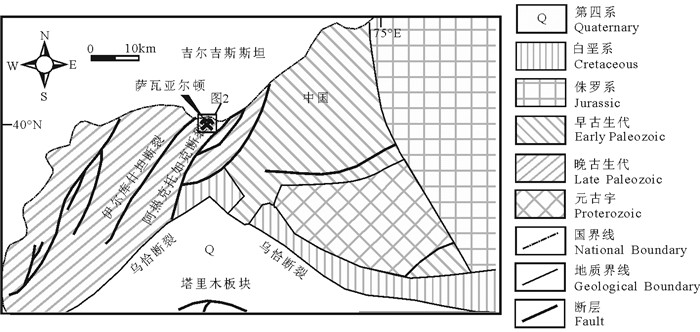
 下载:
下载:
